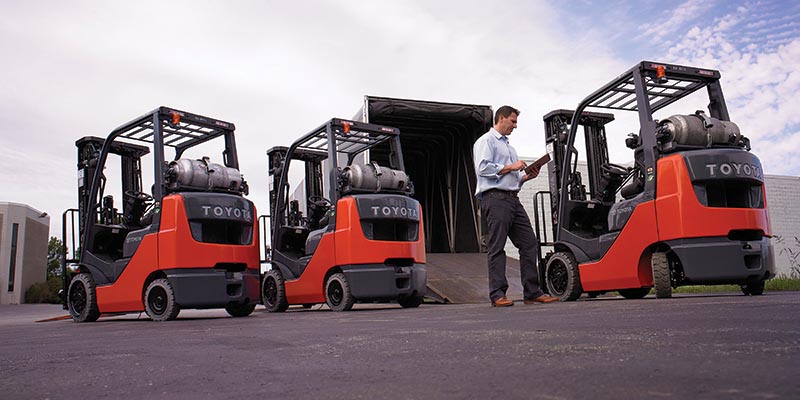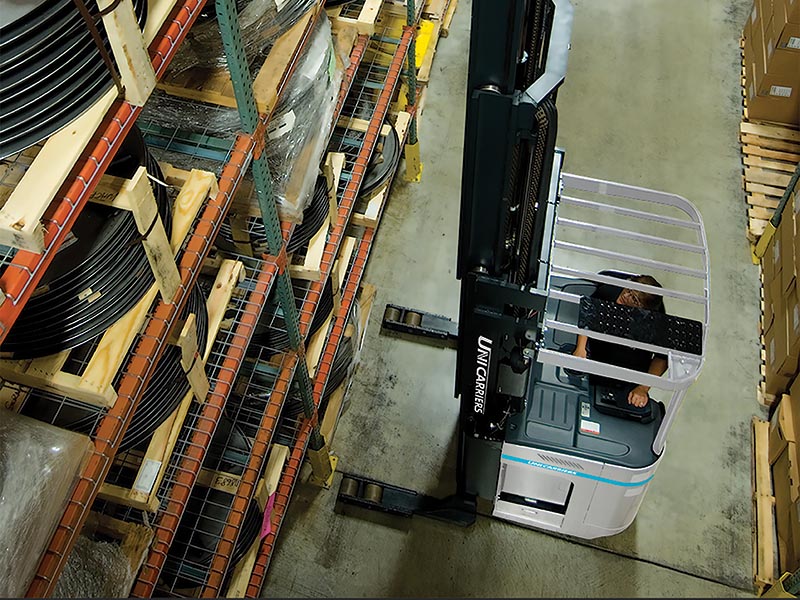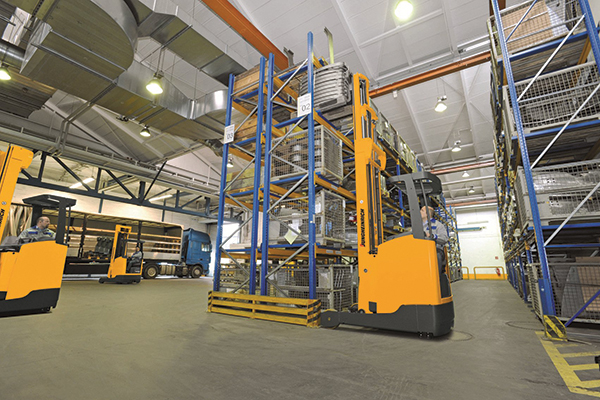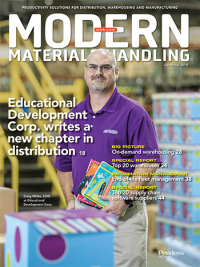End-of-life management: Have a plan
Planning for the inevitable will ensure low costs, high productivity and improved safety across your lift truck fleet.
There are plenty of reasons to get excited about acquiring new forklifts. New technology and the latest in efficiency, safety and productivity can be real difference makers. There’s a lot to like about new forklifts, but the end of a forklift’s life is not as rosy.
“Most customers struggle with planning for the end of life of assets,” says Bill Byrd, national manager of national account sales at Toyota Material Handling. “They don’t have a plan until they have a problem.”
Some companies have an asset depreciation schedule that doesn’t match the application, says Byrd. They may have seven-year depreciation when effectively the usable life is over in five years, while others run 4,000 hours a year depreciated over seven years to 10 years. For many, the natural ebb and flow of business can set a well-intentioned schedule off course. He even describes a customer that traditionally rotated equipment every 10 years.
“But when the economy goes through peaks and valleys, the discipline to maintain that plan can get out of sync, and they end up in catch-up mode and looking at a large capital expenditure,” says Byrd. “It’s unfortunate, but some wait until they’re boxed into a corner.”
Those with a plan fare better. For a customer with seasonal peaks—or for which 50% of shipping comes in the last week of the month—it’s possible to build a plan around those unique situations. There’s a lot more flexibility in financial merchandising offerings, according to Byrd, as dealers and leasing companies enhance the flexibility to, for example, pay by the hour or pay for only what you use. “The local dealer can bring tremendous value to the customer,” he adds, “as long as they’re willing to communicate and collaborate.”
Anticipating costs
Among the many benefits of fleet management programs, whether they include telematics or not, is their ability to prevent spending good money after bad. The data can illustrate the break-even point between the value of an aging asset and its cost to maintain. For the 60% to 70% of forklifts that are leased, this information has changed the end-of-life equation.
“Just because it’s the end of the lease or they have a five-year replacement schedule, that doesn’t matter because fleet management shows it’s still economical to operate that forklift,” says Charlie VandenBosch, director of North American sales for UniCarriers Americas. “We’re now seeing trucks staying for eight years to 10 years with large, intensive users because they know they will not have a major problem.”
The trend of holding on to trucks much longer started to manifest itself when dealers noticed fewer good quality used forklifts in the market, VandenBosch says. Many customers had made a deliberate decision to keep internal combustion forklifts eight years and electric for 10 years. That was quite a switch from what they were five years ago, he adds, when replacement was closer to every five years. “Now, instead of returning equipment to dealers to recondition for rental fleets, they’re sending fully expended assets to the scrap yard,” VandenBosch says.
Yet still, VandenBosch says that a lot of customers who lease don’t fully understand all of their lease options. For a five-year fair market value lease, they might give it back to the dealer when it has another good five years or 10,000 hours.
“They have turned over a valuable asset not realizing they have options to extend the lease another three years, buy it, or use it until it’s scrap,” VandenBosch says. “Depending on the residual value on a model, it’s possible that they have given up 20% of the forklift’s value. Some of the persistent bad practices we see involve not fully understanding lease options.”

On the flip side of that coin are those who use the flexibility of lease options to their fullest. Nick Adams, general manager of national accounts for Mitsubishi Caterpillar Forklift America, says that in addition to economics and safety, flexibility is one of the three main categories that influence end-of-life decisions.
Adams emphasizes that retail distribution—a large user of materials handling equipment—is becoming a bigger and bigger part of the market. Distributors and third-party logistics companies need to keep up with changing SKUs, he says, and they need flexibility around what they handle and how they handle it.
“We live in a nimble world. That changes end-of-life decisions because it changes what we consider ‘life,’” Adams explains. “Sometimes it’s not pure economic life, it’s about: Can the equipment do what I need it to do? SKUs change, picking processes change, inbound putaway processes change, so economic life isn’t dictating disposal or changing that equipment out.”
Instead, end-of-life practices include more up-front negotiations, whether rental, lease or own, to ensure the flexibility to match equipment to changing applications.
Maintaining costs
The durability and reliability of lift trucks has increased in the past decade or so, which contributes to users’ decisions to keep them longer. In fact, Byrd says customers who might have retired a truck at 12,000 hours now find they last 15,000 hours to 20,000 hours. However, this makes it even more important to keep disciplined records of maintenance costs over the life of the asset. Specifically, it’s critical to be able to isolate those costs that are preventive maintenance and those that stem from operator-induced abuse.
On a pie chart of maintenance expenses, Byrd suggests about half is preventive, 25% wear and tear, 10% abuse, and 10% tires and wheels. As the asset ages, the preventive portion gets smaller, but if wheels and tires become greater than 20%, there’s a problem. Byrd encourages customers to meet with a local dealer to review quarterly or annually the costs and the maintenance spend. The dealer can provide clarity on both the overall fleet and the granular per-truck level.
“They can tell you which assets have a normal cost per hour based on the application, versus those that exceed normal—and why,” Byrd says. “Unfortunately, most customers don’t invite the dealer in for a conversation until they have written so many checks that somebody starts asking questions. They wait until the cost to repair is greater than the value.”
On the other hand, many are too focused on maintenance costs to factor in downtime, Byrd says, and a revenue-producing asset that’s not producing revenue leads to soft costs that add up quickly.
The equation is different between manufacturers and distributors, VandenBosch adds. For a production company using forklifts to bring in raw materials and move out finished goods, forklifts are a necessary evil and might not enjoy much scrutiny—unlike someone whose business is moving freight, where forklifts are a part of the business.
In either case, VandenBosch stresses the importance of communication between the leasing company and dealers. Dealers should be presented with what’s coming due for a given customer and bring that information to the customer at least a year in advance of the end of the lease term. This is the time to look at how the asset is being used, how it was specced originally, its repair records and any issues the customer has had.
“You learn a lot by going through these records,” says VandenBosch. “If the leasing company communicates well in advance, it benefits all parties.”
Something as simple as forklift rotation can prevent large expenses, VandenBosch says, especially in applications where there is a homogeneous group of forklifts that are easily interchanged. One year before the end of the term, you might find one forklift with 2,000 fewer hours, or one costing $1.75 an hour and another $2.50 an hour. “What’s the difference in operation between those two? Then you either change assets around or spec it differently,” VandenBosch says. “The data drives all of this.”
The tools to collect that data and build awareness are more accessible than ever. Adams remembers having some of his first conversations around telematics 20 years ago, but he says it wasn’t until the last three to five years where some pretty dramatic changes started taking place. “It’s no longer just for fleets of more than 3,000,” he adds. “Twenty-truck fleets are deploying telematics because the value of the data hit the sweet spot.”

The labor issue
This is particularly true in terms of the labor management element of fleet management. Labor is a scarce resource, Adams says, both for operating and repairing the equipment. Larger users utilize telematics as well as more labor management to get visibility into when workers enter the building and log onto the lift truck.
“Who is driving? Are they trained? What are they doing on the machine? How many hours is the machine being used?” asks Adams. “They’re tracking pick cycles, shipment cycles. They’re looking at a lot of data to understand the productivity of the lift truck and the labor.”
Operator turnover also requires more attention to the safety of the operator. Adams says users are keen to ensure they have equipment that uses all of the latest technology to keep the operator safe, recognizing that they might not be as experienced. Collision avoidance and sensing technology, similar to what is increasingly common in cars, can help maintain safety and productivity.
“There’s a risk of exposure, they believe, by not having some of the most current safety technology,” Adams says. “When the labor market is tight, safety becomes a more prominent concern.”

Article Topics
MRO News & Resources
Avidbots showcases autonomous cleaning robots Traka exhibits modular lockers MRO Survey: Finding and keeping the best technicians Maintenance, Repair and Operations: Understanding the true condition of the equipment Newly formed Bison combines AMETEK DFS and Bison Gear and Engineering Corp. Building (and maintaining) your maintenance, repair and operations (MRO) tech workforce The power side of lift truck battery and charger maintenance More MROLatest in Materials Handling
Registration open for Pack Expo International 2024 Walmart chooses Swisslog AS/RS and software for third milk processing facility NetLogistik partners with Vuzix subsidiary Moviynt to offer mobility solutions for warehouses Materials Handling Robotics: The new world of heterogeneous robotic integration BSLBATT is looking for new distributors and resellers worldwide Lucas Watson appointed CSO for Körber’s Parcel Logistics business in North America Hyster recognizes Dealers of Distinction for 2023 More Materials HandlingAbout the Author
Subscribe to Materials Handling Magazine

Find out what the world's most innovative companies are doing to improve productivity in their plants and distribution centers.
Start your FREE subscription today.
April 2024 Modern Materials Handling

Latest Resources












